[ad_1]
Welcome, coaches and athletes! Are you looking to improve your performance and better understand the human body during exercise? Look no further! In this article, we will try to better understand what triggers high lactate levels during exercise.
The body produces and uses lactate during exercise. We will explore what lactate is, the different roles it plays in the body, and most importantly, why lactate levels may rise during intense physical activity.
By understanding the science behind high lactate levels, you can take steps to improve your performance and reach your goals. So, let’s get started and unlock the secrets of lactate!
Before we go there, let’s first start by understanding Lactate itself.
What is Lactate?
Lactate is the byproduct of glycolysis. This means that when the body uses sugar to fuel muscular contractions and cellular work, the end product of that process is lactate. Lactate was first found in 1780 (in sour milk). In 1808, Jacob Berzelius determined that lactate was produced inside exercising muscles. But we had to wait for 1873 before we knew the actual structure of lactate.
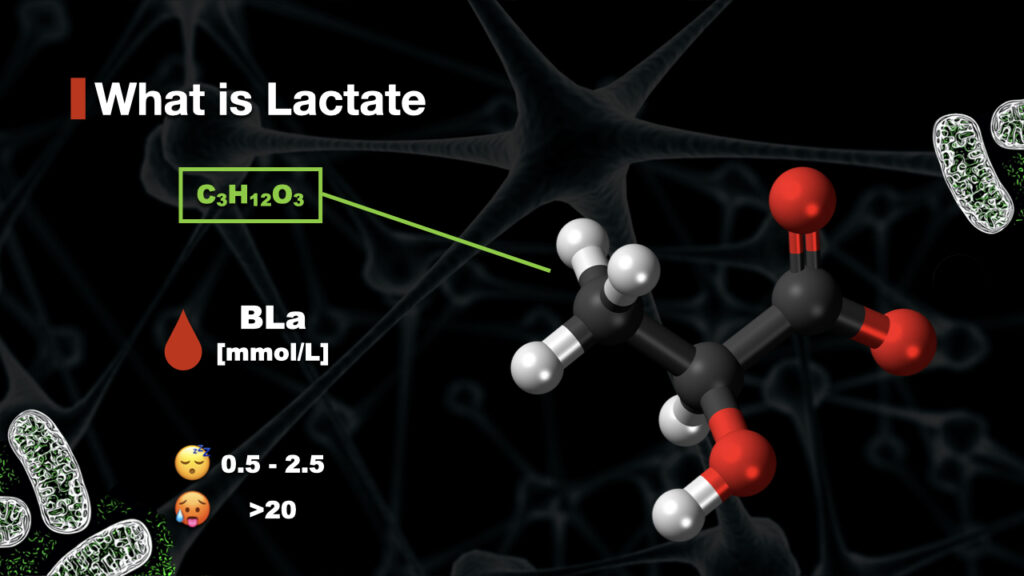

From a structural standpoint, we could easily describe lactate as a half sugar molecule. We can measure lactate levels inside the muscle directly in a lab setting. However outside of a research or medical setting, we have to measure blood lactate, or the concentration of lactate inside the blood.
Blood lactate is expressed in mmol/L. A normal lactate range at rest is usually between 0.5 and 2.5 mmol/L. When it comes to high lactate levels during exercise, values above 20 mmol/L can be measured in very powerful athletes (track cyclists and rowers for example). But for most people, the highest blood lactate possible (even after very intense efforts) is somewhere between 5 and 15 mmol/L.
High Lactate Levels at Rest: What Does it Mean?
Many factors influence lactate levels (even at rest). Nutrition, hydration, fatigue, elevation are all parameters that can drive lactate levels up (or down) depending on the situation. Medical professionals define “high lactate at rest” above 2 mmol/L. Above 4 mmol/L, the patient is suffering from lactic acidosis. In general, when someone displays high lactate levels at rest it indicates an increased reliance on glycolysis and/or insufficient levels of oxygen available. Oxygen is necessary to oxidise fats but also to recycle lactate inside the cell’s mitochondria.
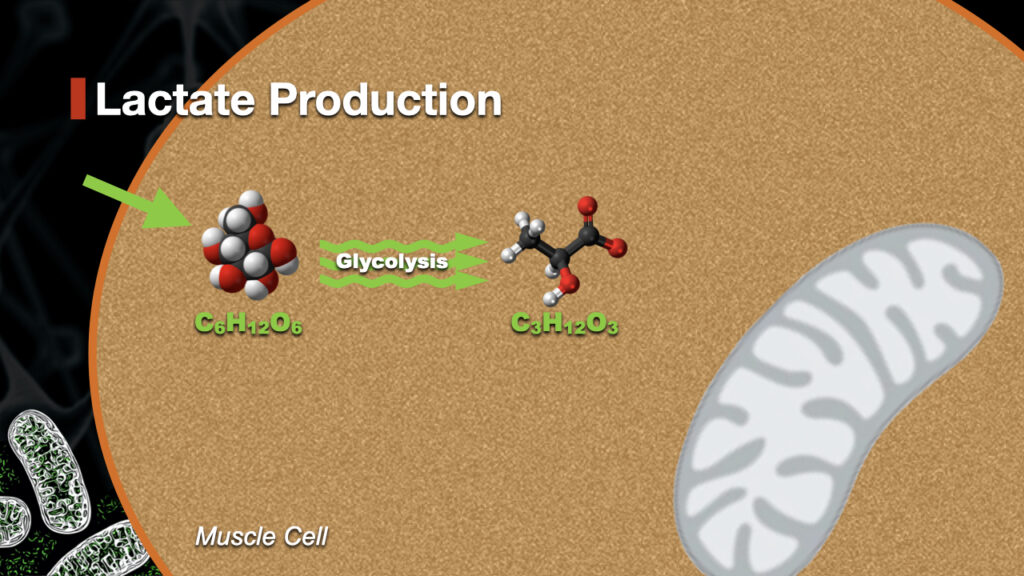

Lactate VS Lactic Acid
Knowingly or now, many people still use the term lactic acid when they should instead use lactate. These two molecules aren’t identical but are very close. As it turns out, “there is no such entity as lactic acid in any living cell or physiological system” (Robergs, 2017). In light of this evidence, coaches and athletes should update their vocabulary to reflect our current understanding of human physiology.
With a better grasp on what lactate is and how it works inside the human body, we will now talk about the three main roles that lactate plays inside the human body.
What Roles does Lactate Play in the Body?
According to world renowned lactate researcher and pioneer George Brooks, lactate plays 3 major roles in the human organism.
Lactate as a Fuel
Lactate is first and foremost a source of energy for the body. Multiple organs such as the brain and the heart preferentially use lactate as a fuel. And while muscle cells produce lactate, they can also reuse (or oxidise) lactate inside the mitochondrial reticulum.
At rest, slow twitch muscle fibres (also called type 1 fibres) are net lactate producers. But their role switches once physical activity begins. At that point, they become “recipient cells” and utilise/dispose of lactate, usually lowering lactate levels inside the cell and the blood.


As such, lactate bridges the gap between glycolytic activity (sometimes still called anaerobic metabolism) and oxidative metabolism. It plays a pivotal role in human bioenergetics.
Lactate as a Signalling Molecule
Lactate down-regulates lipolysis (the breakdown of fat stores into available Free Fatty Acids in circulation). It also has a negative impact of FFA entry into the mitochondria and their oxidation. Said simply, when lactate levels rise, fat oxidations goes down. The graph below is a great illustration of this phenomenon.
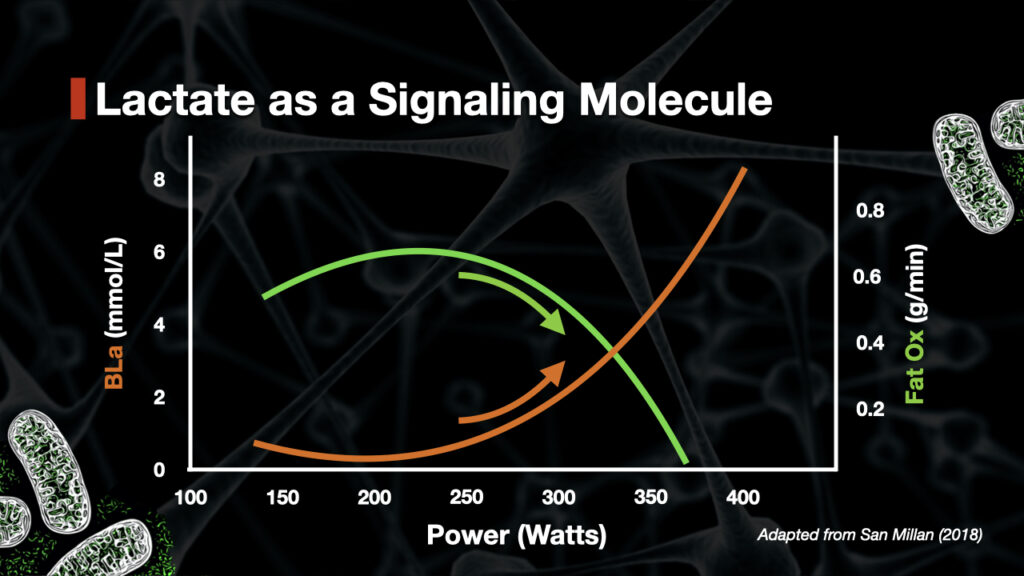

Lactate also affect other areas via signalling. It is understood to have an impact on cell redox state, ROS (reactive oxygen species) production, inter-organ communication, gene expression, inflammation and more. Lactate is truly a key metabolic regulator inside the body.
Recomposing Glucose When Lactate Levels Rise
The third role played by Lactate is as an important gluconeogenic precursor. Gluconeogenesis is essentially the reversal of glycolysis. It occurs inside the liver.
This metabolic pathway is part of the Cori Cycle. The Cori Cycle describes the cycle that happens between glucose and lactate inside the muscle as well as the reverse inside the liver. High lactate isn’t required for those reactions to occur. However, more lactate gets turned back into sugars during and after exercise (when there is an increase in lactate levels).
Now that we understand the important roles that Lactate plays inside our bodies, let’s try to understand why lactate levels increase during exercise.
High Lactate Levels in Exercise: Why Do They Occur?
When talking about elevated lactate during exercise, it’s interesting to think about it in 3 distinct phases along the intensity spectrum.
Phase 1: Lactate Levels Equal Resting Lactate Levels
At low relative intensities, lactate measure in the blood remains low. Often times, blood lactate will stay close to (or even below) resting levels. This is because the mitochondrial network inside the muscle (or cell) is able to “cope” will the lactate flux. Through oxidative metabolism, the mitochondria disposes of all the available lactate.
Phase 2: Increased (But Stable) Levels of Lactate
Once intensity rises above the first lactate threshold, we start to see slightly elevated levels of lactate in the blood. Blood lactate rises above its baseline while still remaining steady.
This occurs when the speed of lactate production outpaces the maximal lactate reuptake capacity of the mitochondria. Now that the mitochondria can no longer bear the full load imposed upon it, it has to outsource its oxidation efforts to the whole body. As seen previously, there are many pathways lactate can follow once it enters the bloodstream.
Phase 3: High Lactate Levels Increasing Exponentially
As intensity keeps rising, we eventually pass the second lactate threshold. Beyond this point, lactate levels in the blood don’t remain stable anymore. We have exceeded the body’s maximal lactate steady state capacity.
We then see an exponential rise in lactate levels. Along with quickly increasing blood lactate, we will usually reach VO2max and task failure soon thereafter.
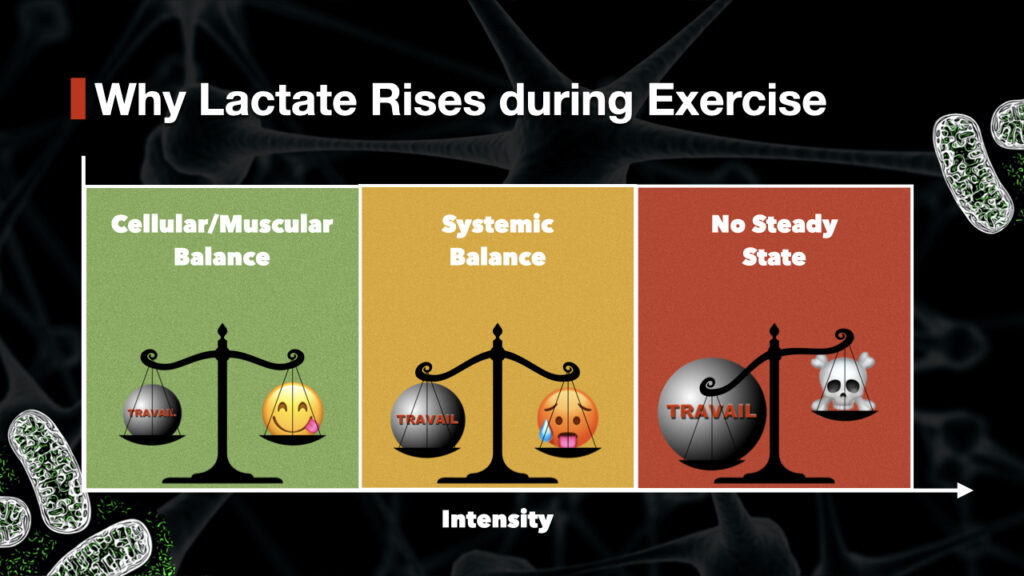

High lactate in the blood is the result of an overpowered mitochondrial network. The more mitochondria you have, the more lactate you can recycle. If you’re wondering how you can increase your mitochondrial density, David Bishop presented a great Keynote on the topic. You can find it here for free.
How To Know When Lactate Rises
When it comes to blood lactate level changes, there exists an incredible difference between demographics. Fitter athletes (like elite cyclists) can pedal at impressive power outputs (>300w) while still maintaining very low lactate.
If you are competitive in your sport and wish to train in a targeted way, it’s important to go through a physiological assessment to determine your individual training intensities.
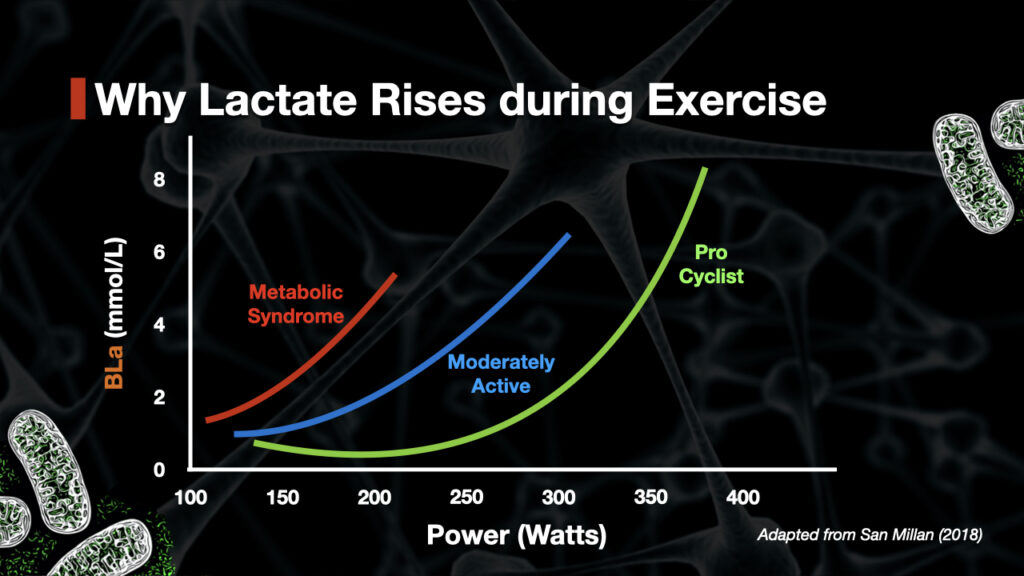

What This Presentation on Why Lactate Rises During Exercise
Thanks for reading this blog! If you’d like to review this content in video format, check out the full presentation linked below.
See you in the next blog!


Author
Sean Seale – Upside Strength
Sean is a Performance Coach specializing in physiological testing for CrossFit and Endurance Sports athletes (cycling, running, triathlon, swimming, etc.). Sean also works as a consultant and trainer for gym owners, sports organizations (regional and national), and coaches wishing to deepen their knowledge or their approach in this area.
Get in touch – Learn more
Click here to get Smoothies For Weight Loss discounted price while it’s still available…
[ad_2]



4 Comments
Đến với J88, bạn sẽ được trải nghiệm dịch vụ cá cược chuyên nghiệp cùng hàng ngàn sự kiện khuyến mãi độc quyền.
iwin – nền tảng game bài đổi thưởng uy tín, nơi bạn có thể thử vận may và tận hưởng nhiều tựa game hấp
Với giao diện mượt mà và ưu đãi hấp dẫn, MM88 là lựa chọn lý tưởng cho các tín đồ giải trí trực tuyến.
kuwin sở hữu kho game đa dạng từ slot đến trò chơi bài đổi thưởng, mang đến cho bạn những giây phút giải trí tuyệt vời.